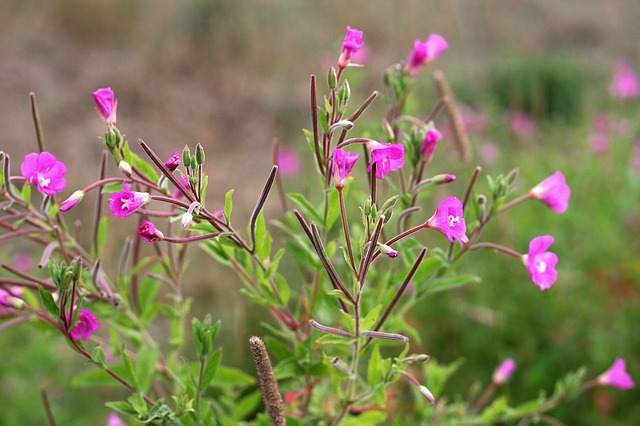
 |  |  |   |   |
 |  |  |
Great Willowherb
is a perennial plant, 50-180 cm tall. It has a strong rhizome and a strongly branching stem. The stem is hairy throughout. The leaves are arranged oppositely and only the upper ones are arranged alternately. The leaves of the
great Willowherb
are sessile, elongated lanceolate or simply elongated, with the tips bent down. The edge of the leaf is finely toothed. The flowers of the
great Willowherb
are solitary and grow from spikes, on average up to 2.5cm in diameter. The flowers are purple. The seeds form in pods, which grow from 4-10cm long.
The plant blooms in summer, starting at the end of June. Most often, the plant chooses to grow in wet places - near rivers or swamps.
All parts of the plant are collected for medicinal purposes. Leaves are collected during budding and flowering - flowers are usually collected separately. Roots are dug in autumn or early spring. Dry the above-ground part of the plant on sieves, in well-ventilated and shaded rooms or in forced dryers at a temperature not exceeding 45C. The roots are dried in forced dryers by cutting them into pieces, the roots are dried at a temperature not exceeding 50C.
Saponins, phloroglucin, sterols, tannins, traces of alkaloids, vitamin C, flavonoids, phenolcarbonic acid and its derivatives have been found in the
great Willowherb
.
Medicinal significance
In the world, this plant is starting to be studied little by little and to return its use for medicinal purposes, because it is really not one of the most popular medicinal plants today. This plant is often confused with the narrow-leaved fire flower, and in various popular information sources you will find descriptions of the narrow-leaved fire flower under the name
great Willowherb
or Epilobium hirsutum - especially in the publications of Western countries. Therefore, when reading about this plant, it is worth comparing information, because even though they are plants of the same family, their chemical composition is strongly different.
The
great Willowherb
is a valuable medicinal plant, this is justified by the substances contained in the plant, which we discussed above.
Preparations made from this plant are endowed with emollient, anti-inflammatory, hemostatic and astringent properties. Recent studies show that the plant can also help against Candida glabrata, Staphylococcus aureus and Methicillin-resistant S. aureus.
The flavonoids present in the plant help to strengthen capillary walls, which is the basis for antispasmodic and antitumor effects. The coumarins in the plant have pain-relieving, temperature-reducing, vasodilating and antimicrobial effects.
Great Willowherb
flower decoction or powder, 6-10 gr. it is preferable to take it orally, in case of toothache. In this case, you can rinse your mouth with a decoction of the plant. Decoctions of gooseberry are effective in the treatment of conjunctivitis, tracheitis and menstrual disorders, as well as leucorrhoea.
Great Willowherb
is a powerful helper for maintaining the health of men and women, it effectively treats inflammations of the intimate area, preventing them from causing more significant problems - therefore, this plant is one of the plants that are used prophylactically against oncological diseases.
A decoction of the root is used if you have managed to overeat, in case of various types of abdominal pain and in case of amenorrhea.
A strong decoction of the root and stem of the plant is used externally: for the treatment of various injuries, fractures and boils. In addition, such a concentrated decoction can be used to stop external bleeding.